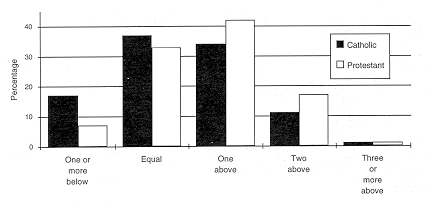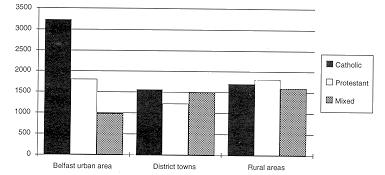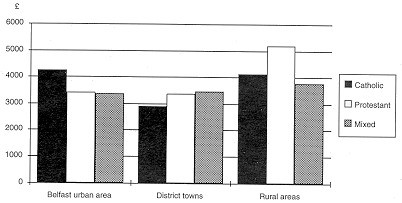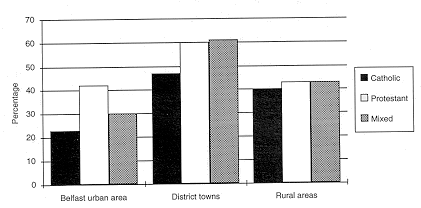Housing and Religion in Northern Ireland by Martin Melaugh
Section 8: The Second Report of the Standing Advisory Commission on Human
Rights INTRODUCTION
The Second Report of the Standing Advisory Commission on Human
Rights (SACHR), Religious and Political Discrimination
and Equality of Opportunity in Northern Ireland (SACH
R 1990) included an assessment of the impact of public housing
provision in Northern Ireland. This assessment was based on research
commissioned by SACHR and carried out by the Policy Studies Institute
(PSI). The PSI produced a report Equality and Inequality
in Northern Ireland, 4: Public Housing (Smith and Chambers
1989), on the basis of its research[1]; the principal
findings were included in an annex to the SACHR report. The terms
of reference for the PSI investigation were set by the Commission.
The PSI was to look at three questions: equality of access by
Catholic and Protestant households to public housing, the quality
of public housing occupied by these groups, and the effect the
public housing system had on segregation and integration. This
Section reviews the findings of the PSI report and also SACHR's
comments on the evidence presented to it. The PSI report began by pointing out that: "There is a broad consensus in Northern Ireland that the Housing Executive has succeeded in removing public housing from sectarian politics, and vice versa." (Smith and Chambers 1989 p3). It was noted that the NIHE did not, at that time, collect information on religion, this policy being justified in terms of maintaining a 'religion blind' stance. The then policy did, however, place substantial limitations on the type and extent of any analysis carried out into the impact the Housing Executive was having on the two main communities. As was pointed out by the authors: "the Executive ... is not in a position to compare applicants, allocations or housing conditions as between the two groups." (p4). Given the lack of direct information on the religion of tenants and those wishing to become tenants the PSI was forced to determine religion by reference to the type of estate where the tenant lived or applicant wished to live. The classification of public housing estates into Catholic, Protestant or mixed was one of the most problematic aspects of the methodological approach used by the PSI. The process of classification was carried out by an advisor who consulted with local housing officials. The PSI acknowledged the limitations of this approach: "the classification relies on informal knowledge, not on a head count, and...the definitions are not quantitative, but descriptive, and are therefore open to different shades of interpretation." (p8). As described in Section Seven a later report by the NIHE had obtained tenants' assessments of the type of estate they lived in (NIHE 1990). This information led the NIHE to conclude there was more mixing than the PSI report implied. Nevertheless, in 74.6 per cent of estates the NIHE and PSI classification would have coincided. It would probably be fair to say that the NIHE were unhappy at the procedures adopted by the PSI for assigning religion to estates.
In its investigation the PSI used a number of sources of information:
"...the Continuous Households Survey 1983-85; the Public
Sector Maintenance Survey 1985-86; applicants registered on the
waiting list at the end of 1987; and allocations made during 1987."
(Smith and Chambers 1989 p6). The PSI report began by providing "a broad description of the pattern of housing of Protestants and Catholics based on analysis of the Continuous Household Survey 1983-85." (Smith and Chambers 1989 pl 2). Much of this information was covered in the discussion of the CHS in Section Seven. The PSI report noted the differences in tenure between Catholic and Protestant households and also the fact that this pattern reflected the social class structures in the two communities. The report also made a number of observations about the pattern of segregation in housing. The CHS data confirmed that Protestants, as the majority group, were more likely than Catholics to live among people of the same religion, and that segregation was greatest in Belfast: "The findings fit with the theory that the operation of the public sector of housing in Northern Ireland tends to encourage segregation between Protestants and Catholics to a greater extent than the private sector." (Smith and Chambers 1989 pl 5). On the issue of density of occupation the PSI report was able to consider information broken down by both tenure and religion. For all tenures the evidence was similar to that presented in Section Seven, namely that, "Although Catholic households tend to be substantially larger than Protestant ones, they do not tend to occupy larger accommodation..." (pl5). Information on the bedroom standard showed that owner occupiers were more likely to be living in dwellings which were two or more rooms above the standard. The picture across all tenures was that Catholic households were more likely to be living in dwellings which were one or more rooms below the bedroom standard. Whereas this distinction in owner-occupied and private rented dwellings could arguably be explained in terms of consumer choice in a free market, the position in public sector housing was harder to explain (see Figure 8.1):
Among tenants of the Housing Executive, we find that
17 percent of Catholic households compared with 7 per cent
of Protestant households have fewer bedrooms than the standard.
Also, the proportion of Housing Executive tenants with
extra space is higher among Protestant households (59 per
cent) than among Catholic households (45 per cent). In
this important respect, therefore, Protestant families
within the public sector tend to have a higher quality
of accommodation than Catholic families. (pl6).
dwellings that are below, equal to or above the bedroom standard  Data for Figure 8.1 Housing conditions The PSI report pointed out that there were differences in the age and structure of dwellings on Catholic and Protestant estates. Dwellings on Catholic estates tended to be of a more recent construction than those on Protestant estates. This finding was attributable to factors considered in Section Two of this report. It was also the case that "Catholic estates have a slightly higher proportion of houses (71 per cent) than Protestant (67 per cent)" (Smith and Chambers 1989 p25). On the issue of differences in the physical condition of dwellings, the PSI investigation used the two main factors considered by the NIHE in maintenance assessments. These are the state of repair and failure to meet the 'basic dwelling standard'. The state of repair assessment covers items of the external and internal structure of the building such as windows, the roof, plumbing and facilities, and determines the amount of work that is required to achieve an acceptable standard of repair. Items in the basic dwelling standard include things such as stability, dampness, space, lighting, heating and insulation, and this assessment is designed to provide an assessment of the work needed to improve the dwelling to the current standard for new housing. The PSI report considered two expenditure measures, the average (mean) repair cost, and the average (mean) improvement cost. The report found that for Northern Ireland as a whole, "The average repair costs are substantially higher for Catholic estates (£2,234) than for Protestant (£1 603) or mixed estates (£1 9452)." (p27). No significant difference in the average improvement costs was found for Northern Ireland as a whole. In Belfast there were large differences in repair costs between Catholic (£3,225) and Protestant areas (£1,798), see Figure 8.2.
 Data for Figure 8.2 Improvement costs also tended to be higher on Catholic estates in Belfast. In the district towns the improvement costs (see Figure 8.3) on Protestant estates (£3,366) tended to be worse than Catholic estates (£2,895), white there were only marginal differences in the average repair costs. In rural areas the repair costs were similar, but Protestant estates had the higher improvement costs (Protestant £5,173, Catholic £4,137). The PSI report makes the point that differences in the age and structure of estates in Belfast should, other things being equal, have the effect of producing higher average repair costs on Protestant estates. it is conceivable that some repair may be required as a result of the larger average family size found in Catholic estates, but it is unlikely to account for the level of difference mentioned above.
religion of estate, 1985-86  Data for Figure 8.3 Access to public housing The PSI again faced problems in trying to answer the question of whether or not there was equal access to public sector housing for Catholics and Protestants. The point was made in the report that the best information would be found by following a pool of subjects who went through the allocation process. The only information that was available, however, was that collected as part of the housing management system. While this meant that: "the records can be used to give a snapshot of the waiting list on a particular date, and to provide a description of allocations over a given period", here was the limitation that "they cannot readily be used to provide an analysis of the flow from the waiting list into public housing." (Smith and Chambers 1989 p36). This limitation was to have a large effect on the quality of this part of the analysis undertaken by the PSI. The report began by describing the background the Housing Executive's Housing Selection scheme from the system inherited from the NIHT. he selection scheme underwent a number of major reviews and also many adjustments. It has to be remembered that decisions regarding the weighting of elements within a points system are subjective. Furthermore, given the many differences in the characteristics of Catholic and Protestant households, these decisions are likely to have a differential impact on the two communities. The PSI report also made the point that the decisions taken in the process of matching the neediest applicant to a suitable dwelling "may be guided by rules, but these rules do not (and cannot) uniquely determine particular decisions." (p37). As an example of this the Report mentions the "flexible adjustment or bargaining" that can take place when an applicant is visited by their focal housing assistant. The waiting list as operated by the NIHE is divided into the A or priority list containing those in greatest housing need and the general or B list. Points are allocated to applicants for circumstances such as the sharing of facilities, a lack of amenities, overcrowding or focal preference points. Partly as a result of more recent homeless legislation the current situation is that a majority of allocations, approximately 60 per cent, are made to priority cases. The methodological approach taken by Smith and Chambers was to compare allocations during 1987 with the waiting list at the end of that year. During 1987 there were 5,137 transfer allocations of existing NIHE tenants and 9,359 allocations to new applicants. Religion was assigned to applicants according to whether the estate they selected was assessed to be Catholic, Protestant or mixed. This procedure was necessary because the majority of people who complete an application form for the Housing Executive do not answer the voluntary question on religion. (However, as housing allocations are the responsibility of local housing managers who have good knowledge of their area, it is very likely that they are aware of the religion of each applicant from other details on the application form.) The analysis of allocations broken down by the points earned revealed a wide range with 5 per cent of dwellings going to households with 10 or fewer points. The segregation of housing was assumed to be one possible explanation for difficulties in matching dwellings to applicants. When allocations during 1987 were considered as a percentage of the waiting list at the end of the year a fairly clear pattern appeared: see Figure 8.4. In the Belfast urban area, and to a lesser extent in the district towns, there was a marked difference between allocations to Catholic and Protestant estates. The biggest differential was in the Belfast urban area were allocations to Catholic estates were 23 per cent of the waiting list whereas the equivalent figure for Protestant estates was 42 per cent. In district towns the figures were 47 per cent Catholic and 60 per cent Protestant. These differences existed despite the evidence that Catholic housing need was greater than Protestant need during the same period.
waiting list 1987, by region and type of estate  Data for Figure 8.4 The PSI report also noted the differences in the household composition of those preferring Catholic and Protestant estates, for example, there was a higher percentage of families with children among those preferring Catholic estates. The chances of each household type being allocated a dwelling also varied markedly:
The way in which rehoused families are distributed between household types varies considerably between those going to Protestant and Catholic estates. To a large extent, this reflects the characteristics of applicants belonging to the two groups, but there are exceptions: in particular, a higher proportion of allocations to Protestant than to Catholic estates are to single adults (39 per cent compared with 28 per cent) although the proportion of applicants who are single adults is the same for those preferring Protestant and Catholic estates. (p44).
as a percentage of applicants at end- 1987
As a further check on these differences in allocations between household type a table was compiled which considered allocations to each type of household as a proportion of applicants of the same type (this is reproduced here as Table 8.5). The information shows that there were significant differences in both the A and B waiting lists:
... for the A list, the disparities in rehousing chances between the Protestant and Catholic groups are about 2:1 or worse for every household type, and this is true both for Northern Ireland as a whole and for Belfast separately... In the case of B list applicants, the Protestant group has substantially better chances of rehousing than the Catholic group for four out of the six household types. (p45).
Although the PSI report would appear to show important differences
in the probability of being allocated a dwelling in Catholic and
Protestant estates, Smith and Chambers stressed the methodological
limitations of their assessment. The households that were allocated
dwellings during the year of the study were obviously not the
same as those which remained on the waiting lists at the end of
1987. The assumption was made therefore that the households joining
the list during the year were not significantly different in composition
from those that left it. The designation of estates into Catholic,
Protestant or mixed was, as mentioned above, a subjective assessment.
Smith and Chambers also restated the point that, particularly
in Belfast, properties on Protestant estates may be more likely
to become available to new tenants because of a higher proportion
of Protestant leaving public housing for owner occupation. As mentioned above the PSI report was an attempt to answer questions related to equality of access for Catholic and Protestant households, the quality of dwellings occupied, and the effect of the housing system on the process of segregation. The limitations of the data used in the PSI assessment meant that "The results shed light on these questions, though ... they cannot answer them conclusively." (Smith and Chambers 1989 p56). Allowing for the problems caused by the nature of the data, the PSI concluded that while a higher proportion of Catholic households live in public sector housing, those on the waiting list wishing to live on a Catholic estate have a lower chance of being rehoused than those preferring Protestant estates. The broad finding on the question of the quality of dwellings was that there were significant differences, in a number of areas, in the state of repair and dwelling standard of Catholic and Protestant estates: "in the Belfast urban area, Catholic public housing estates are in a considerably worse state of repair than Protestant or mixed estates, and they also require more improvement to bring them up to the basic dwelling standard." (Smith and Chambers 1989 p57). In district towns Catholic estates tended to have a better dwelling standard. In rural areas Protestant estates tended to have the highest average improvement costs. The PSI report noted that there was more segregation in public sector housing than in the private sector. Smith and Chambers speculated that one of the reasons for this may be due to the fact that new public sector housing has been built in perceived religious territories rather than on neutral ground. Another reason may be that the large scale of public housing estates may make it easier for the entire estate to become identified as the 'property' of one section of the community. The Report also suggested that segregation may be an artefact of the bureaucratic process of housing allocation: "It is also possible that the allocation system eventually comes to accept segregation as the norm in many areas, and therefore excludes certain options from consideration altogether." (p57). In terms of equality of treatment by the NIHE the PSI report concluded that "There is no evidence from the findings of this study of direct or intentional discrimination, nor of indirect discrimination, by the Northern Ireland Housing Executive against Catholic applicants or tenants." (p58). In the subsequent SACHR Report the main findings, discussed above, were briefly noted. By way of potential explanation for some of the findings of the PSI report, SACHR detailed the particular extraordinary circumstances that the NIHE was forced to operate up to that point:
The Commission believes, as do its academic advisers, that interpretation of PSI's findings has to take account of a range of factors which must have influenced NIHE's operations over the years. These factors include: public disorder,. population movement,. squatting; intimidation; shortage of land,. and decisions as to its availability. (SACHR 1990 p14). SACHR also commented on the issue of the monitoring of religion by the NIHE. After publication of the PSI report the Commission had discussions with the NIHE about this subject: "The NIHE takes the view that systematic monitoring would create an erroneous impression that religious affiliation is part of the decision making process and that if required by Government to change its stance there would be hostile public reaction." (SACHR 1990 p47). In a significant break with past practice the NIHE did say that it intended to seek information on religion in its sample surveys and other ad hoc research. Since that time the Housing Executive has carried out research which has sought information on religion (see Section Seven). However, the Commission was still of the opinion that only regular monitoring would provide the comprehensive information required and thought that the PSI recommendation regarding monitoring of religious affiliation "deserves careful consideration". Recently the NIHE has announced further changes to the collection of information on religion (NIHE 1991a) and these will be considered in Section Ten.
There is no record of the NIHE's view of the main findings in
the PSI report but it is highly likely that the Executive would
have been critical of a number of the findings. Certainly in
a report published in 1990 the Housing Executive produced figures
which suggested much less polarisation than was the case in the
PSI estimates (NIHE 1990)[2].
NOTES [1] The PSI produced four reports in total on the subject of Equality and Inequality in Northern Ireland, number 1 was on Employment and Unemployment, number 2 covered The Workplace, number 3 was on Perceptions and Views and number 4 examined Public Housing.
[2] The NIHE did carry out an internal assessment of the
accuracy of the PSI classification of estates. Other than three
instances of misclassification by PSI there were no significant
differences in the two classifications. The PSI assessment was
carried out because the NIHE were unable, or unwilling, at the
time of the request to provide the figures. It is unfortunate
that an 'agreed' classification could not be used as the basis
of the investigation.
equal, or above the bedroom standard by religion and tenure
cost for NIHE dwellings in 1985-86
end-of-year waiting list, 1987
| |||||||||||||||||||||||||||||||||||||||||||||||||||||||||||||||||||||||||||||||||||||||||||||||||||||||||||||||||||||||||||||||||||||||||||||||||||||||||||||||||||||||||||||||||||||||||||||||||||||||||||||||||||||||||||||||||||||||||||||||